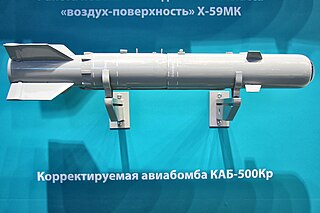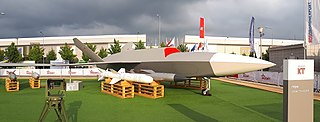
The KAB-500Kr is an electro-optical TV-guided fire and forget bomb developed by the Soviet Air Force in the 1980s. It remains in service with the CIS and various export customers.

The KAB-500L is a laser-guided bomb developed by the Soviet Air Force, entering service in 1975. It remains in service with the CIS and post-Soviet Russian Aerospace Forces.

The Mikoyan MiG-27 is a variable-sweep ground-attack aircraft, originally built by the Mikoyan-Gurevich design bureau in the Soviet Union and later licence-produced in India by Hindustan Aeronautics as the Bahadur ("Valiant"). It is based on the Mikoyan-Gurevich MiG-23 fighter aircraft, but optimised for air-to-ground attack. Unlike the MiG-23, the MiG-27 did not have widespread use outside Russia, as most countries opted for the Mikoyan-Gurevich MiG-23BN and Sukhoi Su-22 instead. As of late 2023, all Russian, Indian, Sri Lankan, Ukrainian, and Kazakh MiG-27s have been retired, bringing the type's service to an end.

The Sukhoi Su-25 Grach is a subsonic, single-seat, twin-engine jet aircraft developed in the Soviet Union by Sukhoi. It was designed to provide close air support for Soviet Ground Forces. The first prototype made its maiden flight on 22 February 1975. After testing, the aircraft went into series production in 1978 in Tbilisi in the Georgian Soviet Socialist Republic.

The Sukhoi Su-24 is a supersonic, all-weather tactical bomber developed in the Soviet Union. The aircraft has a variable-sweep wing, twin engines and a side-by-side seating arrangement for its crew of two. It was the first of the USSR's aircraft to carry an integrated digital navigation/attack system.

A general-purpose bomb is an air-dropped bomb intended as a compromise between blast damage, penetration, and fragmentation in explosive effect. They are designed to be effective against enemy troops, vehicles, and buildings.

The Kh-59 Ovod is a Russian cruise missile with a two-stage solid-fuel propulsion system and 200 km range. The Kh-59M Ovod-M is a variant with a bigger warhead and turbojet engine. It is primarily a land-attack missile; the Kh-59MK variant targets ships.
KAB or kab or variation, may refer to:
The Mikoyan Skat is a concept of a stealth unmanned combat aerial vehicle (UCAV) being developed by Mikoyan for the Russian Ministry of Defence since 2005.

A precision-guided munition (PGM), also called a smart weapon, smart munition, or smart bomb, is a type of weapon system that integrates advanced guidance and control systems, such as GPS, laser guidance, or infrared sensors, with various types of munitions, typically missiles or artillery shells, to allow for high-accuracy strikes against designated targets. PGMs are designed to precisely hit a predetermined target, typically with a margin of error that is far smaller than conventional unguided munitions. Unlike unguided munitions, PGMs use active or passive control mechanisms capable of steering the weapon towards its intended target. PGMs are capable of mid-flight course corrections, allowing them to adjust and hit the intended target even if conditions change. PGMs can be deployed from various platforms, including aircraft, naval ships, ground vehicles, ground-based launchers, and UAVs. PGMs are primarily used in military operations to achieve greater accuracy, particularly in complex or sensitive environments, to reduce the risk to operators, lessen civilian harm, and minimize collateral damage. PGMs are considered an element of modern warfare to reduce unintended damage and civilian casualties. It is widely accepted that PGMs significantly outperform unguided weapons, particularly against fortified or mobile targets.

The Kh-38/Kh-38M is a family of standoff air-to-surface missiles meant to succeed the Kh-25 and Kh-29 missile families. The Kh-38 also serves as the basis for the Kh-36 unpowered and powered glide-bombs.

KAB-1500L is a Russian precision guided weapon, part of KAB-1500 family, a laser guided bomb and also the current production standard for use on 4+ and 4++ generation fighter jets, like the Sukhoi Su-30MKI/Sukhoi Su-30MKK, Sukhoi Su-34 and Sukhoi Su-35. It is claimed to be the Russian equivalent to USA's Paveway II/Paveway III, though it is a much larger device, at 6x the size. As the Paveway is 500lbs, it can generally be considered a closer match to the KAB-500L that uses similar guidance technology and is designed to hit railway, ammunition depots, railway terminals, highway bridges, military and industrial facilities, ships and transport vessels. The KAB-1500LG-F-E has an impact fuze which includes 3 different delay modes for target attack and it can also be mounted on older aircraft, like the Sukhoi Su-24 and the Mikoyan MiG-27.

The KAB-250 is a family of aerial bombs developed in the 2000s. It comes in two forms, the KAB-250LG-E laser-guided bomb and KAB-250S-E satellite-guided bomb. It is being introduced into service with the post-Soviet Russian Air Force since 2020. KAB stands for "Корректируемая Авиационная Бомба" which means "Managed (corrected) aircraft bomb" and refers to high-precision weapons.
The KhAB-250 is the provisional name of an aerial bomb developed by the Soviet Air Force to deliver the chemical weapon sarin.

The FAB-500 is a Soviet-designed 500-kilogram (1,100 lb) general purpose air-dropped bomb with a high-explosive warhead, primarily used by the Russian Aerospace Forces, former Soviet republics and customer countries. The original M-54 model was rolled out in 1954, shaped for internal carriage by heavy bombers, a low-drag M-62 version in 1962 was intended for fighter bomber external hardpoint carriage. Early models were unguided, with a single nose fuze, and compatible with most models of Soviet aircraft.

The KAB-500S-E is a guided bomb designed for the Russian Aerospace Forces and is also the first guided bomb of the Russian Federation. It uses the GLONASS satellite navigation system and is the Russian equivalent of the Joint Direct Attack Munition (JDAM) weapons family. It was first used during the Russian military intervention in the Syrian Civil War. The bomb's first trials were in 2000 and it was displayed at airshows in 2003.

The KAB-1500S-E is a precision guided bomb, part of KAB-1500 family, designed for the Russian Aerospace Forces to carry out precision attacks, using 24-channel GLONASS and is equivalent to the United States Air Force (USAF) Joint Direct Attack Munition (JDAM) family of Global Positioning System (GPS) guided weapons.
KAB-1500 is a Russian precision guided weapon which comes in three versions: KAB-1500L, KAB-1500S-E and TV-guided KAB-1500KR.
The Hass refugee camp bombing was an aerial bombardment of a refugee camp in the Syrian opposition-held town of Hass in the Idlib Governorate of Syria, which has been deemed a war crime by Human Rights Watch. It was perpetrated on 16 August 2019, at 7:25 p.m. local time, during the Syrian civil war. The bombing killed 20 civilians, including a pregnant woman, and injured another 52 people.

Grom is a Russian unmanned combat aerial vehicle (UCAV) being developed by Kronshtadt. It was first unveiled at ARMY-2020 forum.















